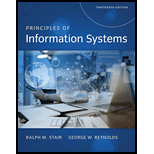
Principles of Information Systems (MindTap Course List)
13th Edition
ISBN: 9781305971776
Author: Ralph Stair, George Reynolds
Publisher: Cengage Learning
expand_more
expand_more
format_list_bulleted
Question
Chapter 12, Problem 1RQ
Program Plan Intro
Waterfall model:
- Waterfall model is the first process model in which each phase is completed before starting the next phase.
- It is the first Software Development Life Cycle (SDLC) approach used for developing the software.
- It includes six different types of phases and they are as follows
- Investigation
- The clear understanding of the problems in a system and solving them is performed in investigation phase.
- This helps in developing the project in less time.
- Analysis
- Gathering the data from the existing system and determining the requirements for new systems is done in analysis phase.
- It defines the user requirements and expectations.
- Design
- The existing program or code is executed according to the required design.
- It mainly depends on user requirements.
- Its aim is to convert the user requirements to a complete system.
- Construction
- Construction phase is used to execute the code according to design.
- It is managed by the group of programmers or developers called development team.
- Integration and Testing
- In integration and testing phase, the individual programs or codes are integrated together and tested as group.
- It is used for finding the errors and solving them.
- Implementation
- It is the last phase of the project development process in which development of the project is implemented and maintained.
- It includes user preparation, site preparation, installation and many such.
Program Plan Intro
Waterfall model:
- Waterfall model is the first process model in which each phase is completed before starting the next phase.
- It is the first Software Development Life Cycle (SDLC) approach used for developing the software.
- It includes six different types of phases and they are as follows
- Investigation
- The clear understanding of the problems in a system and solving them is performed in investigation phase.
- This helps in developing the project in less time.
- Analysis
- Gathering the data from the existing system and determining the requirements for new systems is done in analysis phase.
- It defines the user requirements and expectations.
- Design
- The existing program or code is executed according to the required design.
- It mainly depends on user requirements.
- Its aim is to convert the user requirements to a complete system.
- Construction
- Construction phase is used to execute the code according to design.
- It is managed by the group of programmers or developers called development team.
- Integration and Testing
- In integration and testing phase, the individual programs or codes are integrated together and tested as group.
- It is used for finding the errors and solving them.
- Implementation
- It is the last phase of the project development process in which development of the project is implemented and maintained.
- It includes user preparation, site preparation, installation and many such.
Expert Solution & Answer
Trending nowThis is a popular solution!

Students have asked these similar questions
This battle room is focused on entry level tasks for a network analyst where you will be given trials and reconnaissance, sensor tuning, log aggregation, SIEM queries, and network analysis.
For this week’s project, complete the following tasks:
From your Project Ares portal, LOG IN
Click on LAUNCH GAME.
Select the region NORTH AMERICA
Click on Battle School
Under the BATTLE SCHOOL pop-up window, click on START TRAINING.
Under the BATTLE ROOMS tile, click on ENTER.
Under the NETWORK ANALYST tile, click on PLAY.
Wait for the Battle Room to load. While loading, the BATTLE ROOM button will display red. Once the Battle Room is loaded, the BATTLE ROOM button will turn yellow and the center of the disk display will indicate CONNECTED. Click on the BATTLE ROOM button to enter the Battle Room.
Below the TASKS folder, make sure you click on INSTRUCTIONS to download the Network Analyst Fundamentals material.
In the Battle Room, under the TASKS menu select task INTRUSION DETECTION.
Complete…
Create a relationship between the common field (Technician Number) of the two tables. Make sure that each client must have 1 and only 1 technician assigned, and each technician can have multiple clients.
2. Create a query to show the Client Number, Client Name, Billed, Paid for clients in Anderson city. Save the query.
3. Create a query to show the Technician Number, Last Name, First Name, YTD Earnings for technicians whose Hourly Rate is greater than or equal to 30. Save the query.
4. Create a query to show Client Number, Client Name, Billed, Paid for clients whose technician number is 22 and whose Billed is over 300. Save the query.
5. Create a query to show the Technician Number, Last Name, First Name, Client Number, Client Name for clients whose technician number 23. Save the query.
6. Create a query to show the Technician Number, Last Name, First Name, Client Number, Client Name for clients whose technician number 23 or 29. Save the query Help please Microsoft office access
Dijkstra's Algorithm (part 1). Consider the network shown below, and Dijkstra’s link-state algorithm. Here, we are interested in computing the least cost path from node E (note: the start node here is E) to all other nodes using Dijkstra's algorithm. Using the algorithm statement used in the textbook and its visual representation, complete the "Step 0" row in the table below showing the link state algorithm’s execution by matching the table entries (i), (ii), (iii), and (iv) with their values. Write down your final [correct] answer, as you‘ll need it for the next question.
Chapter 12 Solutions
Principles of Information Systems (MindTap Course List)
Ch. 12.2 - Outline the tasks that must be accomplished to...Ch. 12.2 - Following your discussion, one of the team members...Ch. 12.2 - There is likely to be some confusion over the role...Ch. 12.2 - Prob. 2CTQCh. 12.3 - Prob. 1RQCh. 12.3 - Prob. 2RQCh. 12.3 - Prob. 1CTQCh. 12.3 - What other potential problems can you anticipate...Ch. 12.4 - Prob. 1RQCh. 12.4 - Prob. 2RQ
Ch. 12.4 - Prob. 1CTQCh. 12.4 - A safety-critical system is one whose failure or...Ch. 12 - Prob. 1SATCh. 12 - _______________ software can provide a better...Ch. 12 - Prob. 3SATCh. 12 - Prob. 4SATCh. 12 - The purpose of the system investigation phase is...Ch. 12 - ______________ is a diagram used to document the...Ch. 12 - The overall emphasis of the __________ phase is on...Ch. 12 - The primary tool for assessing the software...Ch. 12 - Prob. 9SATCh. 12 - Prob. 10SATCh. 12 - Prob. 11SATCh. 12 - Prob. 12SATCh. 12 - A preliminary evaluation of software packages and...Ch. 12 - Prob. 1RQCh. 12 - Prob. 2RQCh. 12 - Prob. 3RQCh. 12 - Prob. 4RQCh. 12 - Prob. 5RQCh. 12 - What are the key elements of a system...Ch. 12 - Prob. 7RQCh. 12 - Prob. 8RQCh. 12 - Prob. 9RQCh. 12 - Prob. 10RQCh. 12 - Prob. 11RQCh. 12 - Prob. 12RQCh. 12 - Prob. 13RQCh. 12 - Prob. 14RQCh. 12 - An organization has selected and is now...Ch. 12 - Prob. 1DQCh. 12 - Thoroughly discuss the pros and cons of buying...Ch. 12 - Prob. 3DQCh. 12 - Prob. 4DQCh. 12 - Prob. 5DQCh. 12 - Prob. 6DQCh. 12 - Prob. 7DQCh. 12 - Define the Pareto principle, and discuss how it...Ch. 12 - Prob. 9DQCh. 12 - Prob. 10DQCh. 12 - Prob. 11DQCh. 12 - Prob. 12DQCh. 12 - Identify and briefly discuss four key tasks...Ch. 12 - A new sales ordering system needs a relational...Ch. 12 - Prob. 2TACh. 12 - You and your team have been hired to perform a...Ch. 12 - Prob. 1WECh. 12 - Prob. 2WECh. 12 - Do research to determine the current level of...Ch. 12 - Prob. 1CECh. 12 - Prob. 2CECh. 12 - Identify an information system frequently employed...Ch. 12 - It is perhaps not surprising that Etsy was an...Ch. 12 - Prob. 2CTQ1Ch. 12 - What would be some of the criteria you would use...Ch. 12 - Prob. 1CTQ2Ch. 12 - Prob. 2CTQ2Ch. 12 - Prob. 3CTQ2
Knowledge Booster
Similar questions
arrow_back_ios
SEE MORE QUESTIONS
arrow_forward_ios
Recommended textbooks for you
 Principles of Information Systems (MindTap Course...Computer ScienceISBN:9781305971776Author:Ralph Stair, George ReynoldsPublisher:Cengage Learning
Principles of Information Systems (MindTap Course...Computer ScienceISBN:9781305971776Author:Ralph Stair, George ReynoldsPublisher:Cengage Learning Fundamentals of Information SystemsComputer ScienceISBN:9781337097536Author:Ralph Stair, George ReynoldsPublisher:Cengage Learning
Fundamentals of Information SystemsComputer ScienceISBN:9781337097536Author:Ralph Stair, George ReynoldsPublisher:Cengage Learning Systems ArchitectureComputer ScienceISBN:9781305080195Author:Stephen D. BurdPublisher:Cengage Learning
Systems ArchitectureComputer ScienceISBN:9781305080195Author:Stephen D. BurdPublisher:Cengage Learning Principles of Information Systems (MindTap Course...Computer ScienceISBN:9781285867168Author:Ralph Stair, George ReynoldsPublisher:Cengage Learning
Principles of Information Systems (MindTap Course...Computer ScienceISBN:9781285867168Author:Ralph Stair, George ReynoldsPublisher:Cengage Learning Management Of Information SecurityComputer ScienceISBN:9781337405713Author:WHITMAN, Michael.Publisher:Cengage Learning,
Management Of Information SecurityComputer ScienceISBN:9781337405713Author:WHITMAN, Michael.Publisher:Cengage Learning, Fundamentals of Information SystemsComputer ScienceISBN:9781305082168Author:Ralph Stair, George ReynoldsPublisher:Cengage Learning
Fundamentals of Information SystemsComputer ScienceISBN:9781305082168Author:Ralph Stair, George ReynoldsPublisher:Cengage Learning

Principles of Information Systems (MindTap Course...
Computer Science
ISBN:9781305971776
Author:Ralph Stair, George Reynolds
Publisher:Cengage Learning

Fundamentals of Information Systems
Computer Science
ISBN:9781337097536
Author:Ralph Stair, George Reynolds
Publisher:Cengage Learning

Systems Architecture
Computer Science
ISBN:9781305080195
Author:Stephen D. Burd
Publisher:Cengage Learning

Principles of Information Systems (MindTap Course...
Computer Science
ISBN:9781285867168
Author:Ralph Stair, George Reynolds
Publisher:Cengage Learning

Management Of Information Security
Computer Science
ISBN:9781337405713
Author:WHITMAN, Michael.
Publisher:Cengage Learning,

Fundamentals of Information Systems
Computer Science
ISBN:9781305082168
Author:Ralph Stair, George Reynolds
Publisher:Cengage Learning